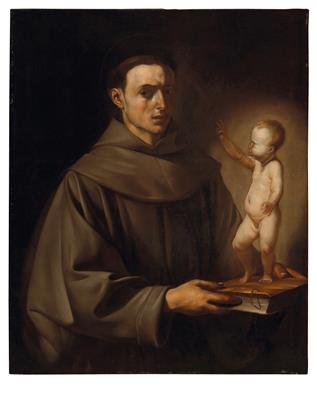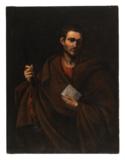Jusepe de Ribera

(Játiva 1591–1652 Naples)
Saint Anthony of Padua and the Christ Child,
oil on canvas, 112 x 91.5 cm, framed
Provenance:
Private collection, Barcelona;
where acquired by the present owner
We are grateful to Nicola Spinosa for confirming the attribution after examining the present painting in the original.
Gianni Papi has dated this work to Ribera’s Roman period, to circa 1612–13.
The present work is typical of Ribera’s paintings of this period, where a single figure is depicted with strong pictorial character. In the present composition Saint Anthony is positioned in the close foreground and is portrayed with an aura of mystery, with simplicity, and in a straightforward manner. The saint’s habit is painted with well defined, confident and sculptural brush strokes which offer a sense of volume. Papi, dates this work to circa 1612–13, around the same time as the Origen in Urbino, Galleria Nazionale delle Marche, (see N. Spinosa, Ribera. La obra completa, Madrid 2008, pp. 323-324, fig. A34). Nicola Spinosa dates the present work to 1614–15.
The subject of the present painting, the vision of the Christ Child by Saint Anthony while in Camposampiero in Padua, is frequently used in depictions of the saint’s life. Ribera chooses not to use the most commonly depicted moment, with the saint in the embrace of the Christ Child, instead depicting the moment just before the embrace. He portrays the vision of the Child in front of the saint, looking at him, standing with his bare feet on a book which serves as a platform. The saint looks out towards the spectator as if inviting him to engage, along with him, with the unexpected apparition.
Throughout Ribera’s work, but particularly during his Roman period, it is possible to recognise recurring facial types, which suggests that the painter often used the same models to create actual ‘portraits from life’. The model for Saint Anthony in the present painting recurs in Saint Thomas (Budapest, Museum of Fine Arts, inv. no. 788), Saint John the Evangelist (Paris, Louvre, inv. no. RF 2021 8), The denial of Saint Peter (Rome, Galleria Corsini, inv. no. 438), in The raising of Lazarus (Madrid, Museo del Prado, inv. no. P007768) where it is employed to portray the figures of both Christ and Lazarus, and in the previously mentioned Origen (Urbino, Galleria Nazionale delle Marche).
It is thought that Jusepe de Ribera, who was a native of Játiva in Spain, may have trained in the studio of Francesco Ribalta in his youth. However, little is actually known of the artist’s activities before his arrival in Parma where his first Italian painting is documented, the Saint Martin and the Pauper for the church of San Prospero (now lost). The fact that he received such an important commission suggests that the artist had arrived in Italy some considerable time earlier and had already been able to create a reputation for himself as a painter.
Ribera travelled to Italy in around 1608, most likely stopping first in Rome, in order to complete his training, studying the Italian masters. Following a period spent in Emilia, Ribera returned to Rome where he remained until 1616, when he moved definitively to Naples. In Rome, the artist steered his choices toward a realist style, influenced by his direct knowledge of the work of Caravaggio and his immediate circle of followers, which included various northern painters, particularly French and Flemish artists who elaborated on the example of the Lombard master. Ribera’s works, however, stand out from among the works of Caravaggio’s many followers. His work reveals an element of originality and an approach, both to his subjects and to his representation of space, that are entirely new, such as is apparent in the present painting.
Specialist: Mark MacDonnell
 Mark MacDonnell
Mark MacDonnell
+43 1 515 60 403
mark.macdonnell@dorotheum.at
11.05.2022 - 16:00
- Realized price: **
-
EUR 69,687.-
- Estimate:
-
EUR 60,000.- to EUR 80,000.-
Jusepe de Ribera
(Játiva 1591–1652 Naples)
Saint Anthony of Padua and the Christ Child,
oil on canvas, 112 x 91.5 cm, framed
Provenance:
Private collection, Barcelona;
where acquired by the present owner
We are grateful to Nicola Spinosa for confirming the attribution after examining the present painting in the original.
Gianni Papi has dated this work to Ribera’s Roman period, to circa 1612–13.
The present work is typical of Ribera’s paintings of this period, where a single figure is depicted with strong pictorial character. In the present composition Saint Anthony is positioned in the close foreground and is portrayed with an aura of mystery, with simplicity, and in a straightforward manner. The saint’s habit is painted with well defined, confident and sculptural brush strokes which offer a sense of volume. Papi, dates this work to circa 1612–13, around the same time as the Origen in Urbino, Galleria Nazionale delle Marche, (see N. Spinosa, Ribera. La obra completa, Madrid 2008, pp. 323-324, fig. A34). Nicola Spinosa dates the present work to 1614–15.
The subject of the present painting, the vision of the Christ Child by Saint Anthony while in Camposampiero in Padua, is frequently used in depictions of the saint’s life. Ribera chooses not to use the most commonly depicted moment, with the saint in the embrace of the Christ Child, instead depicting the moment just before the embrace. He portrays the vision of the Child in front of the saint, looking at him, standing with his bare feet on a book which serves as a platform. The saint looks out towards the spectator as if inviting him to engage, along with him, with the unexpected apparition.
Throughout Ribera’s work, but particularly during his Roman period, it is possible to recognise recurring facial types, which suggests that the painter often used the same models to create actual ‘portraits from life’. The model for Saint Anthony in the present painting recurs in Saint Thomas (Budapest, Museum of Fine Arts, inv. no. 788), Saint John the Evangelist (Paris, Louvre, inv. no. RF 2021 8), The denial of Saint Peter (Rome, Galleria Corsini, inv. no. 438), in The raising of Lazarus (Madrid, Museo del Prado, inv. no. P007768) where it is employed to portray the figures of both Christ and Lazarus, and in the previously mentioned Origen (Urbino, Galleria Nazionale delle Marche).
It is thought that Jusepe de Ribera, who was a native of Játiva in Spain, may have trained in the studio of Francesco Ribalta in his youth. However, little is actually known of the artist’s activities before his arrival in Parma where his first Italian painting is documented, the Saint Martin and the Pauper for the church of San Prospero (now lost). The fact that he received such an important commission suggests that the artist had arrived in Italy some considerable time earlier and had already been able to create a reputation for himself as a painter.
Ribera travelled to Italy in around 1608, most likely stopping first in Rome, in order to complete his training, studying the Italian masters. Following a period spent in Emilia, Ribera returned to Rome where he remained until 1616, when he moved definitively to Naples. In Rome, the artist steered his choices toward a realist style, influenced by his direct knowledge of the work of Caravaggio and his immediate circle of followers, which included various northern painters, particularly French and Flemish artists who elaborated on the example of the Lombard master. Ribera’s works, however, stand out from among the works of Caravaggio’s many followers. His work reveals an element of originality and an approach, both to his subjects and to his representation of space, that are entirely new, such as is apparent in the present painting.
Specialist: Mark MacDonnell
 Mark MacDonnell
Mark MacDonnell
+43 1 515 60 403
mark.macdonnell@dorotheum.at
|
Buyers hotline
Mon.-Fri.: 10.00am - 5.00pm
old.masters@dorotheum.at +43 1 515 60 403 |
| Auction: | Old Master Paintings I |
| Auction type: | Saleroom auction with Live Bidding |
| Date: | 11.05.2022 - 16:00 |
| Location: | Vienna | Palais Dorotheum |
| Exhibition: | 30.04. - 11.05.2022 |
** Purchase price incl. buyer's premium and VAT(Country of delivery: Austria)
It is not possible to turn in online buying orders anymore. The auction is in preparation or has been executed already.

